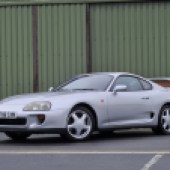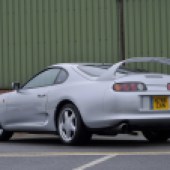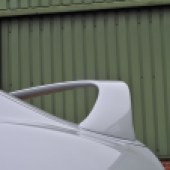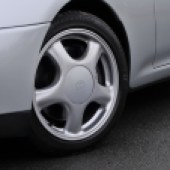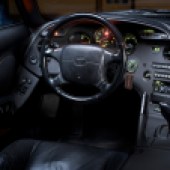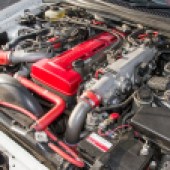A poster car for the Gran Turismo generation, the Toyota Supra is a fantastic sports car that’s become a true modern classic
Images: Paul Wager, Toyota
The Toyota Supra name dates back to the first-generation car in 1978, but its the fourth-generation car of 1993 that’s the most famous today. Codenamed A80, the fourth-gen Supra boasted a notably more muscular aesthetic than its angular predecessor and there was certainly no missing the large hooped rear spoiler that adorned most examples.
Production continued in Japan until 2002 but as far the UK was concerned, the high-performance coupe was rather more short-lived; on sale only until 1996, just somewhere between 500 and 600 examples were sold here officially. Export markets including the UK got the highest-spec version of the car, powered by a twin-turbocharged version of Toyota’s 2JZ straight-six that benefitted from tweaks to the turbochargers and injection system. The result was a beefy 326bhp and 325lb/ft of torque, enough for 0-60mph in less than five seconds. In its native Japan, the top-spec turbocharged Supra topped out at 276hp, as per Japanese manufacturers’ so-called ‘gentleman’s agreement’ to cap power levels. A naturally aspirated version of the car was also offered in Japan; the same engine would make it to the UK under the bonnet of the closely related Lexus SC300 and contemporary Lexus GS300.
In the UK, the Supra’s considerable performance put it squarely in the firing line of the Porsche 911; it was notably quicker and more powerful than a 993-generation Carrera, all with a much lower asking price when new of just £37,500. The Supra also handled well and provided plenty of driving thrills, helped in part by a laser-sharp focus on weight-saving. Around 100kg lighter than the model it replaced, the Supra boasted a magnesium-alloy steering wheel and even hollow carpet fibres in an effort to shed pounds.
As with its Nissan Skyline GT-R and Honda NSX contemporaries, the Supra’s starring role in videogames, films and popular culture, together with its incredible potential for performance tuning, have helped to fuel an incredible rise in values in recent times. The good news is that prices seem to have flattened out at time of writing; perhaps now is the time to take the plunge.
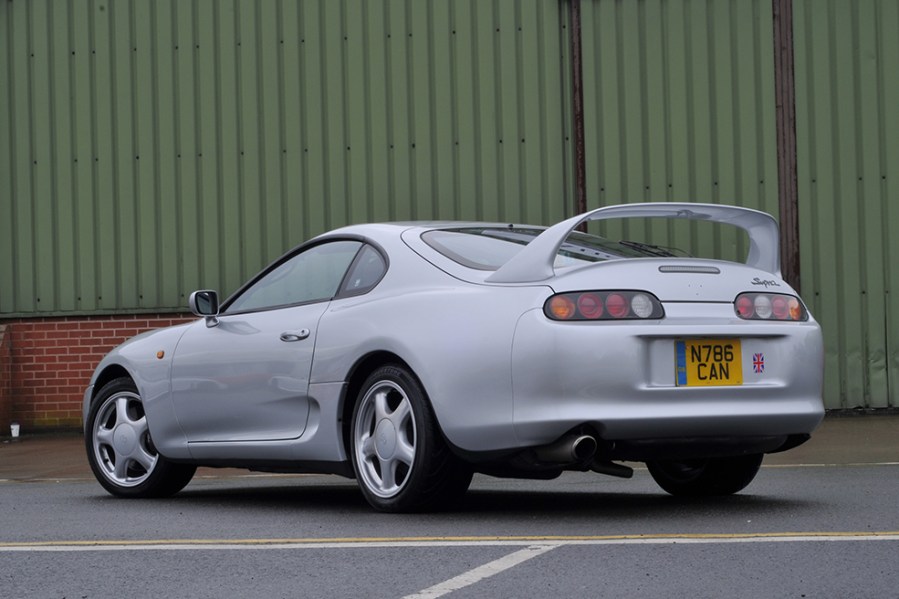
Bodywork
Despite the newest cars being more than twenty years old, it seems that the Supra’s bodywork is holding up pretty well. Neither the the owners club nor specialists note any major concerns, although it would be wise to give all of the panels a proper check and ensure there’s no history of accident damage. The Toyota Supra is a fast car so mishaps aren’t unknown.
The rear wheel-arches are one area to examine for corrosion, especially if they’ve been modified to accept bigger wheels; if side skirts are fitted, make sure rot isn’t festering away behind them. More important is thorough scrutiny of the underside as rust can take hold in chassis sections; check around the seat belt mounts and fuel tank, too. Japanese-market cars lacked the rust-proofing of UK models, and while plenty of cars were protected subsequently you’ll want to be certain that underseal isn’t hiding rust.
As for parts availability, you might struggle to source some new panels but used items are relatively plentiful, either online or from breakers. One last point to mention is the roof, with only Japanese cars getting a targa-style arrangement; it was a solid panel only for UK models, which helps identify the car you’re considering. The presence of a bonnet vent and headlamp washers are another key identifier, both being standard on UK cars.

Engine and transmission
Given the power and performance on offer, particularly in twin-turbo form with UK cars getting steel instead of ceramic turbos and bigger injectors, the A80’s 2JZ-GTE engine proves remarkably durable. John Branigan at Mkivsupra.net says they are almost unburstable, and that well-maintained ones can cover in excess of 200,000 miles before an overhaul might be needed.
The key is looking after the famous 2JZ engine properly, so look for a record of oil changes every 6,000 miles (some owners prefer to do it at half that mileage) and a new timing belt every 50,000 miles. The latter job can cost four figures once you start including additional work, such as replacing the water pump along with various gaskets and oil seals, so budget accordingly.
It’s worth examining the engine for leaks from the cam cover and for signs of perished pipework; focus on the likes of air inlet and oil return pipes. Make sure the cooling system is healthy, too, and consider replacing tired components with uprated items.
A thorough test drive should reveal any signs of exhaust smoke; also check that the second turbocharger joins the party at around 4000rpm, and note that faulty coil packs can be responsible for misfires. The good news is that there are plenty of specialists to look after the Supra, so there’s no excuse for landing yourself with a neglected example.
Tuning should be a consideration as there’s the potential to extract some very impressive power outputs relatively safely. Whether that’s the sort of thing you’re interested in is a matter of personal taste; in any case, it’s well-worth quizzing the vendor to establish what, if any, work has been done. Walk away from home-brew efforts if you want peace of mind.
UK cars got the choice of a Getrag six-speed manual gearbox or a four-speed automatic, while normally-aspirated Japanese models had a five-speed manual. It’s sensible to check that manual gearboxes aren’t suffering from whines or tired synchromesh (second gear is often the first to go), but there are no inherent weaknesses. Bear in mind that the cost of a replacement six-speed can reach five-figures.
A worn clutch and/or rattling flywheel are worth watching for and it’s best to replace both at the same time. If you prefer an automatic (and plenty of buyers did) then it’s mainly a case of ensuring that shifts are smooth. A warning light on the dash can point to issues on the electronic side of things; it’s best to get a specialist diagnosis before committing to a purchase.
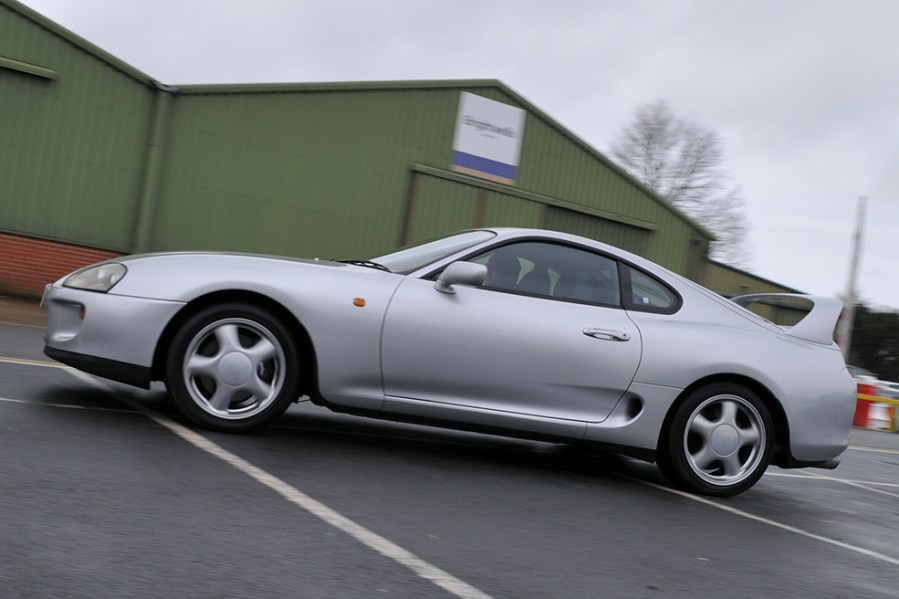
Suspension, steering and brakes
The carefully-tuned multi-link suspension is well up to the job of keeping everything pointing in the right direction, and unless dampers and bushes have been allowed to deteriorate there shouldn’t be anything to worry about. But like other aspects of this Supra there is plenty of scope for upgrades, so be sure to establish what’s been done. Fitting coil-over units is a common mod and there is plenty of choice on the market; budget anything from £700 to £2000 depending on brand and the level of adjustability, but also beware poor DIY installation jobs that may have upset the car’s geometry or made it unduly stiff. Worn bushes can be swapped for polyurethane items at the cost of a few hundred pounds but standard items will retain more refinement. Clonks and rattles from worn anti-roll bar links are easy to sort.
The hydraulically-assisted steering provides plenty of feel and should be pleasingly precise on the road, so anything else warrants investigation. Any issues are likely to point to worn joints, as the system itself isn’t known to be troublesome, but spend a bit of time checking that perished pipework hasn’t led to fluid leaks.
In standard form the beefy discs and calipers are more than up to the job (UK cars got larger items as standard), so unless the car you’re considering has had a power boost there’s no real reason to take the upgrade route. You could fit mildly uprated discs and pads to add a little extra confidence but it’s not really necessary. If you suspect a car hasn’t seen much use, it is worth checking that calipers aren’t sticking; this can lead to warped discs, so use the road test for check for any tell-tale vibrations. And be sure to check there are no issues with ABS operation.

Interior and trim
While you wouldn’t really class the interior as being luxurious, there won’t be any complaints about how it’s been assembled. Build quality was a strong point, and with plenty of equipment and a sound driving position this version of the Supra makes a good long-distance sports car. You’ll soon spot any worn or damaged trim, and the leather that was standard on UK cars can be revived by a trimmer if necessary, but assuming everything is tidy it’s just a matter of ensuring that everything works as it should.
Electrical hassles are rare, but a prod of all the switchgear will put your mind at rest as will a check of the air-conditioning; the latter can be pricey to fix and a previous owner might have just ignored an inoperative system. Lighting for the instruments and switches can fail but it’s a fairly straightforward fix, and about the only other think to check is the powered adjustment of the driver’s seat. Worn or broken gears within the mechanism can cause it to become stuck with no fore/aft movement possible, and repairs can be a bit of a headache.
Ensure that any upgrades to the likes of instruments and audio systems have been done properly and that aftermarket alarms and immobilisers aren’t causing issues of their own. An unmolested and undamaged cabin is a pleasant place to be and only adds to the Supra’s feeling of usability.
Toyota Supra (A80): our verdict
The 1990s weren’t short of tempting performance coupes, from the mainstream and affordable to the rather more premium. And while plenty of buyers might have headed for their nearest Porsche showroom, it would have been something of a shame to ignore the Toyota Supra.
With no shortage of power and performance on tap, and the sort of detailed development that Toyota is famed for, the Supra offered entertainment and everyday usability in equal measure. And those same attributes are still very much in evidence today, especially if you take the time to find a cherished example. Fundamentally strong and impressively reliable with proper maintenance, it’s easy to see how you could run one every day and enjoy a cracking blend of easy-going commuter and B-road thriller.
Add in the helpful and knowledgeable club support and numerous specialists and it’s a car we’d urge you to consider. The tuning scene can muddy the water a bit, so you’ll want to decide whether that’s a route you want to take, but we would be more than happy with everything that a standard example can offer.
Values were heading skywards at one point but seem to have settled back of late. A budget of £20,000 should be enough to bag a nice normally aspirated car with a sensible mileage and solid maintenance history. Good manual cars start at closer to £25,000, a price-point where you’ll also find decent turbocharged automatics; a particularly nice one of those will need another £5000, although cars fitted with a manual are more sought-after. While UK cars might fetch a little more, there’s not a great of difference between those and Japanese market models.
Don’t be surprised to see very good examples of the Supra commanding £50k or more; we’ve seen the best advertised for up to £100,000. That’s a healthy sum, but there’s no need to pay that much to experience this desirable modern classic.
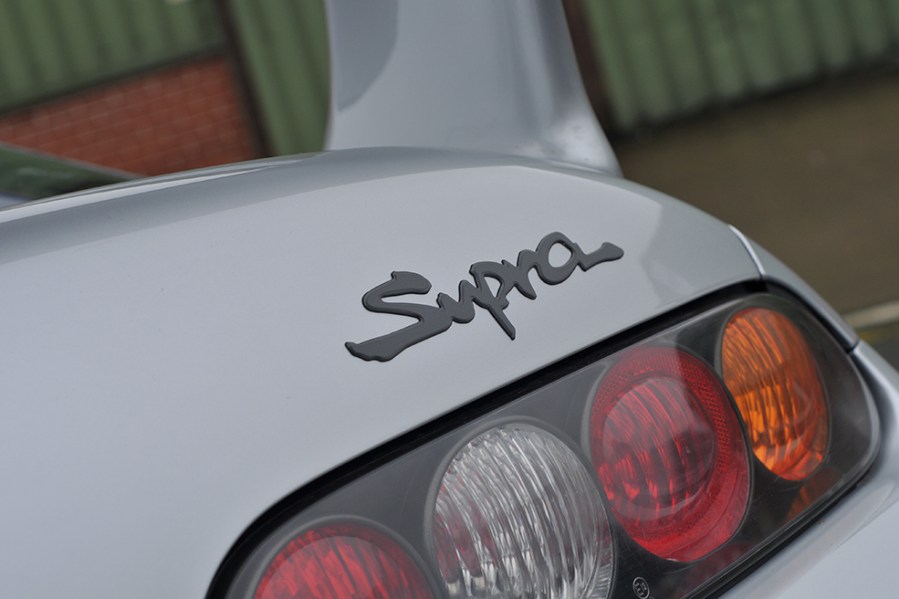
Toyota Supra (A80) timeline
1993
Replacing the A70 model, the fourth-generation Supra is launched at the Chicago Motor Show. UK sales begin the same year, with all cars getting a powerful twin-turbocharged engine.
1996
Official UK sales end with 500 to 600 examples finding buyers. Plenty more would find their way to the UK via the personal import route.
2002
Production finishes in Japan. A fifth-generation Supra wouldn’t arrive until 2019.


